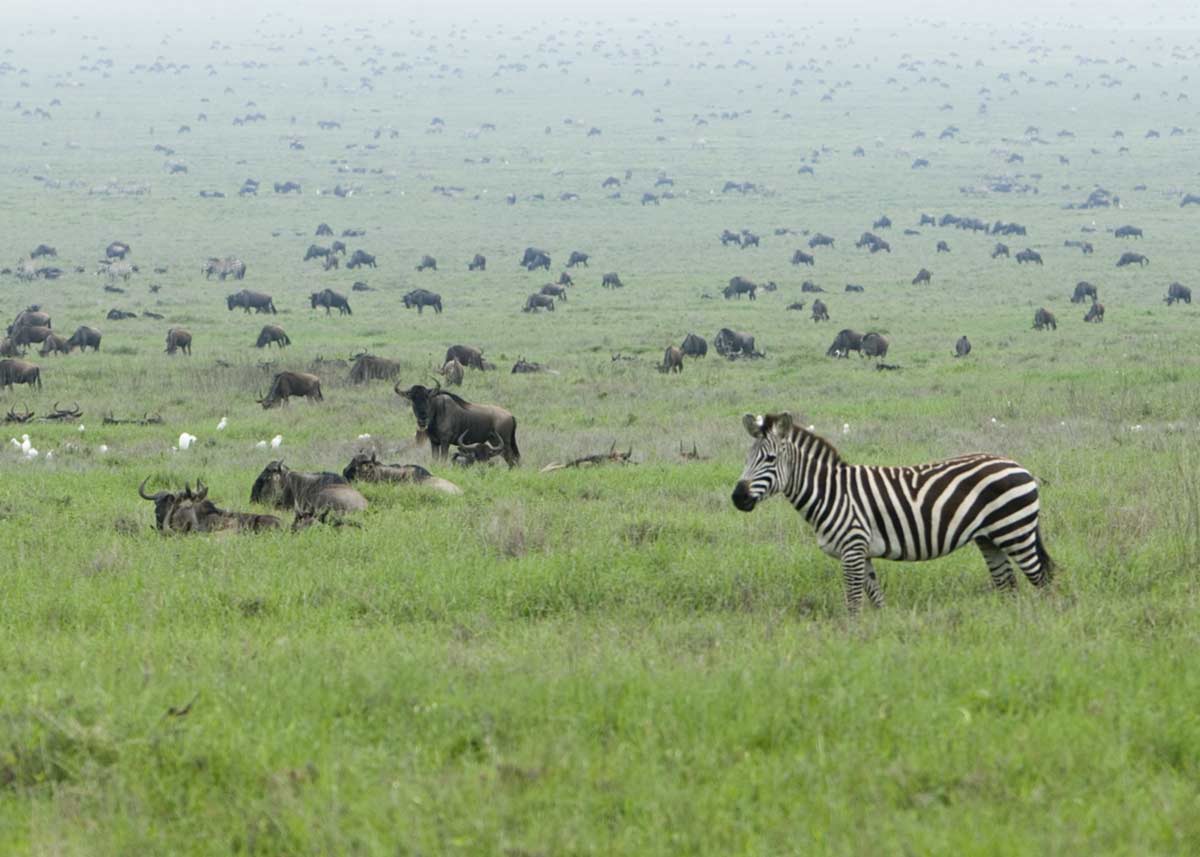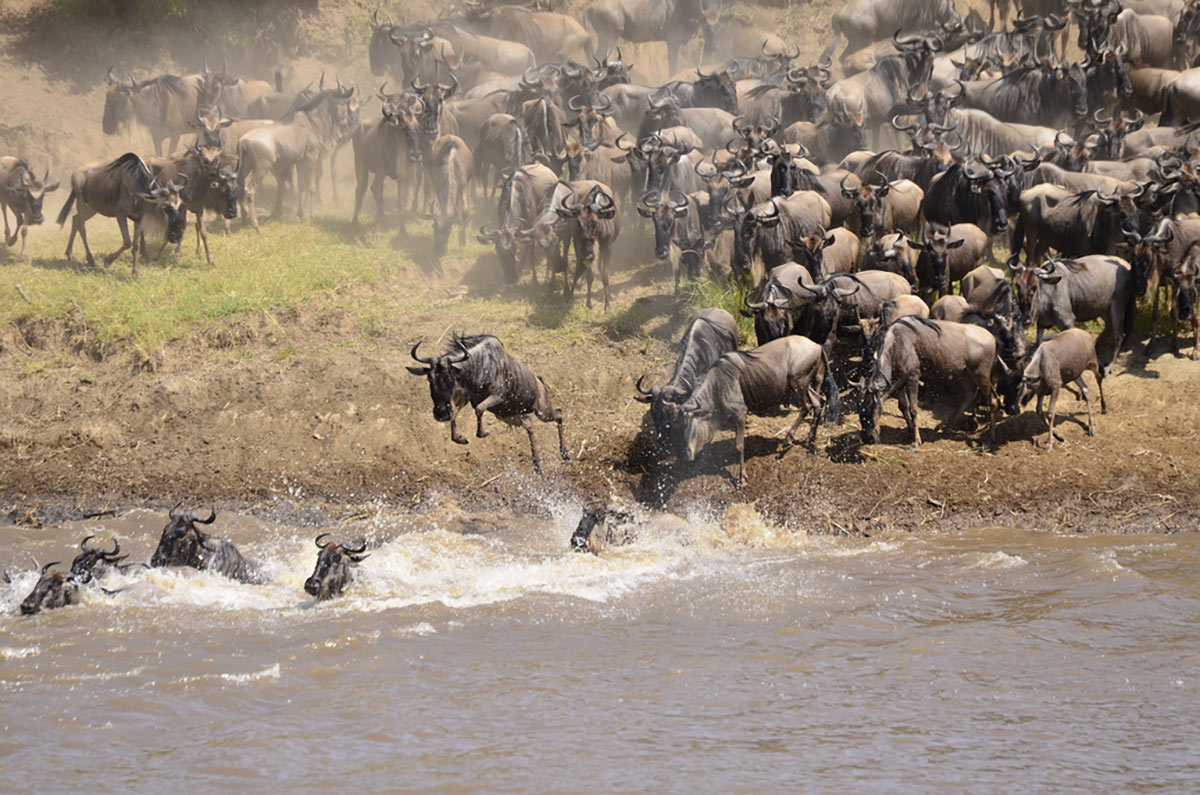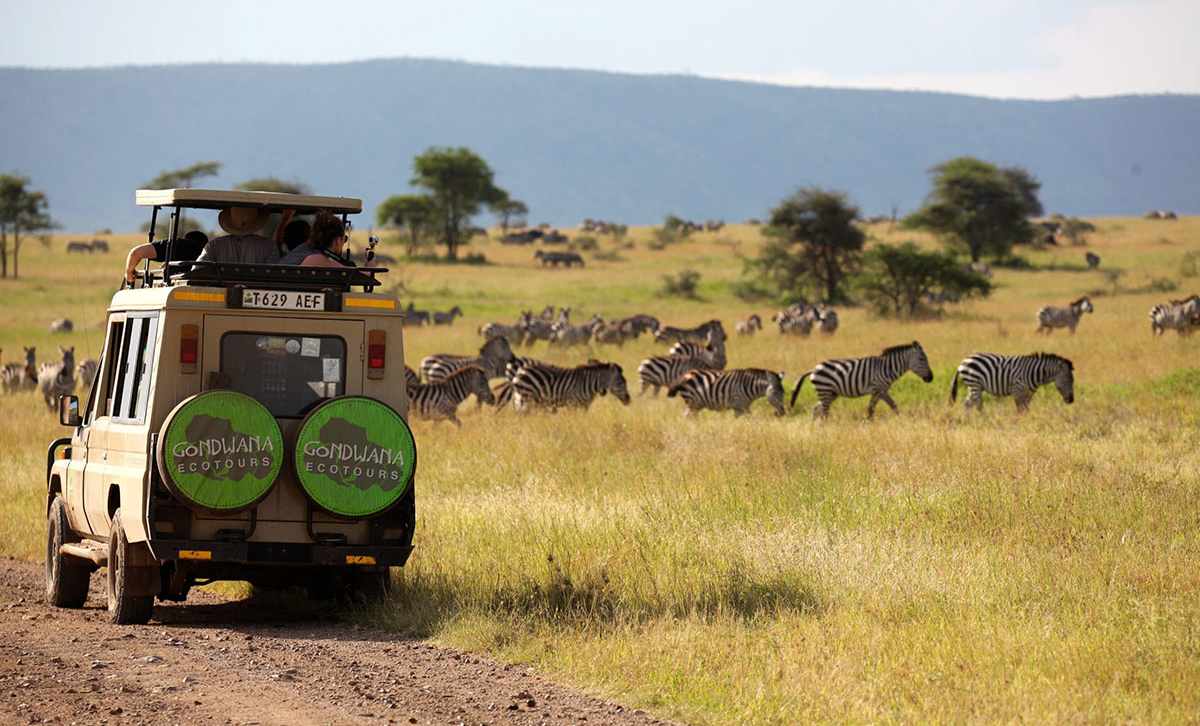The Great Migration is a true spectacle to witness and a wildlife viewing experience that is understandably on many people’s travel bucket lists. In this article, we are going to answer some of the most-asked questions about the Great Migration.

What is the Great Migration in Africa?
The Great Migration: the name says it all. This truly is the world’s most spectacular wildlife migration where millions of animals roam across East Africa.
The Great Migration is a continuous, year-long journey of over a million animals between the Serengeti in Tanzania and the Masai Mara in Kenya. The animals migrate in a constant cycle in search of fresh grazing lands, water, and safe places to give birth to their calves.
After calving in the southern part of the Serengeti in Tanzania, near the Ngorongoro Conservation Area, the animals move north and around in a clockwise direction through the Serengeti National Park and towards the Masai Mara in Kenya. Near the end of the year they return to the Serengeti. The journey can be treacherous and dramatic. Thousands of animals die on the trek, but thousands of calves are also born to complete the circle of life.
Where does the Great Migration take place?
 The Great Migration sees animals trekking along a circular route across the Serengeti-Mara ecosystem, from Tanzania to Kenya, and back round to Tanzania. This is a completely natural phenomenon, so the exact route depends on environmental factors such as the weather, and the animals themselves, but with millions of animals on the march, it is hard to miss.
The Great Migration sees animals trekking along a circular route across the Serengeti-Mara ecosystem, from Tanzania to Kenya, and back round to Tanzania. This is a completely natural phenomenon, so the exact route depends on environmental factors such as the weather, and the animals themselves, but with millions of animals on the march, it is hard to miss.
Many travelers and wildlife enthusiasts flock to the Serengeti and Maasai Mara National Parks during the Great Migration to witness this awe-inspiring spectacle firsthand. The thundering hooves of the wildebeests, coupled with the graceful movements of zebras and gazelles, create a mesmerizing sight as they traverse the open plains and perilous river crossings. The predators lurking nearby, ready to seize any opportunity for a meal, add an element of suspense to this natural theater. For those fortunate enough to experience the Great Migration, it is a humbling reminder of the raw power and beauty of the natural world.
What month does the Great Migration happen in Tanzania?
Some of the best times to view the Great Migration in Tanzania are January and February, and June and July.
At the start of January the migrating herds will be finishing a southward trek, moving along the eastern edge of the Serengeti and into the Ngorongoro Conservation Area. Throughout January and February, the herds occupy the short-grass plains that spread over the lower northern slopes of the Ngorongoro Crater highlands and around Olduvai Gorge. These plains are rich in nutritious grass, which is ideal for the animals to raise their newborn calves. Around 400,000 calves are born here within two to three weeks, this is nearly 8,000 every day!
In June and July, the herds are grazing their way through the Serengeti and pushing northwards towards the Masai Mara, prompted by the end of the rainy season. This is traditionally thought of as the best season to view the migration. The vast plains become a spectacular sight as the wildebeest, zebras, and gazelles journey through the savannah in search of fresh grazing grounds, attracting predators and tourists alike. The river crossings are particularly thrilling during this period, where crocodiles lie in wait for the perfect opportunity to ambush their prey as they navigate through the rushing waters.
What causes the Great Migration in Africa?
The primary driver behind the Great Migration is that the animals are looking for food and water. Due to this, rain patterns have the ultimate say in the herds’ movements. The Great Migration is a complex chain of events including mating, calving and feeding, all of which are influenced by the subtle changes in rainfall that occur year over year. After the animals have given birth to their calves in Tanzania, once the rainy season is over, the south and east plains of the Serengeti dry out, prompting the beginning of the migration northwards.
As the herds continue their journey northwards from the Serengeti, they face various challenges and obstacles that test their endurance and instincts. The predators lurking along the migration route heighten the tension and urgency, pushing the animals to maintain a constant state of alertness. Moreover, the changing landscapes present new opportunities but also unknown dangers, forcing the herds to adapt swiftly to survive the evolving conditions. The Great Migration is not just a physical journey for the animals but a test of their resilience and adaptability in the face of nature’s unpredictable course.
What type of wildlife can I see during the Great Migration in Tanzania?
All the iconic African species can be encountered during the Great Migration. It is hard to miss the enormous herds of migrating wildebeest, zebra, and antelope. The African Big Five includes lions, leopards, elephants, rhinos, and buffalo, all of which you may spot while in Tanzania. You may also see iconic African birds like vultures, hornbills, and bee-eaters on your safari.
During the Great Migration in Tanzania, you may also have the chance to witness some extraordinary wildlife interactions. Predators such as lions and leopards often lurk around the migrating herds, seizing opportunities to hunt and feed. The sight of a lioness stealthily stalking her prey or a leopard blending into the savanna before launching an attack is a thrilling experience for any safari-goer. Additionally, the dynamic relationship between different species, like the symbiotic bond between oxpeckers and large mammals, further enriches the safari experience, offering a deeper understanding of the intricate ecosystem at play in the Tanzanian wilderness.
Where can I see the Great Migration on an African safari?
The circuit of the Great Migration takes the animals from the Ngorongoro Conservation Area in the south of the Serengeti in Tanzania, up through the Serengeti, across into the Masai Mara in Kenya, and back around again. You can witness the Great Migration in Kenya or in Tanzania. The border between the two countries is the area where some of the iconic river crossings happen.
Many travelers opt to visit both Kenya and Tanzania to fully experience the Great Migration phenomenon. The Masai Mara in Kenya is known for its sweeping savannahs and abundant wildlife, offering a unique perspective on the migration. Meanwhile, the Serengeti in Tanzania boasts vast grasslands and a chance to witness predators in action during the migration. Combining the two countries in your safari itinerary will provide a comprehensive and unforgettable safari experience.
Where is the best place to see the Great Migration in Africa?
The Great Migration takes place in Tanzania and Kenya, and is a loop between the Serengeti and the Masai Mara. In the North of Tanzania, some of the best places to see the Great Migration are Arusha National Park, Tarangire National Park, Lake Manyara, and Serengeti National Park. This is where the huge herds are passing through, ready to enter the Masai plains of Kenya, north of the border. Plan an affordable African safari adventure, where you can immerse yourself in the wonders of the continent without breaking the bank. Experience the thrill of spotting the Big Five and other iconic wildlife species while enjoying comfortable accommodations and expert guidance. With careful planning and budget-friendly options, an affordable African safari promises unforgettable memories without compromising on quality or excitement.
Is the Great Migration in Tanzania worth seeing?
Absolutely! The Great Migration in Tanzania is a spectacle like no other, offering an awe-inspiring display of nature’s grandeur. As the countless wildebeest, zebras, and other animals traverse the Serengeti plains in search of greener pastures, the sheer magnitude of this annual event is truly breathtaking. The sights and sounds of thousands of hooves thundering across the landscape, accompanied by the occasional roar of predators, create an unparalleled sensory experience that leaves a lasting impression on all who are fortunate enough to witness it. Whether you are a wildlife enthusiast, a nature lover, or simply someone in search of a truly unforgettable adventure, the Great Migration in Tanzania is an experience that will stay with you long after you return home.
The Great Migration is the largest herd movement of animals on the planet— and it is definitely worth seeing! With up to 1,000 animals per square kilometer, the great columns of animals can be seen from space. Witnessing the Great Migration in person is a unique opportunity to see the power of nature at work, and to see some of the most magnificent and iconic creatures on Earth.
What animals participate in the Great Migration?
Wildebeest are the best known species for taking part in the Great Migration, and they are the most numerous participants. They are accompanied by Zebra, Topi, and other antelope.
With so many herbivores moving through the landscape, it is no surprise that predators are spotted too. Lions, leopards, cheetahs, hyenas, wild dogs and crocodiles might be seen in the area, searching for a meal. As the herbivores continue their journey through the vast expanse of the Great Migration, the predators play a crucial role in maintaining the delicate balance of the ecosystem. These apex predators rely on the influx of prey to sustain themselves and their offspring, leading to intense moments of life and death in the wilderness. The predators’ keen hunting instincts and strategies are put to the test as they navigate through the sea of potential meals, creating a spectacle of survival that captures the raw essence of nature in its purest form. Each encounter between predator and prey serves as a reminder of the intricate interconnection between all living beings in the wild, shaping the ever-evolving tapestry of life on the African savannah.
How many animals are in the Great Migration?
The claim that millions of animals are part of the Great Migration is no exaggeration. Up to 1.4 million wildebeest are known to take part, along with 300,000 zebras, as well as thousands of other species of iconic African animals.
The vast number of animals involved in the Great Migration is truly a spectacle to behold. As these massive herds move across the East African plains in search of greener pastures, the landscape comes alive with the thundering hooves of wildebeest and the striking stripes of zebras. Each species plays a unique role in this awe-inspiring journey, showcasing the power of nature’s interconnected ecosystem. The sheer scale of this migration serves as a reminder of the resilience and adaptability of these magnificent creatures in the face of challenging environmental conditions.
Why does the Great Migration happen?
The Great Migration happens because the animals are moving with the seasons, searching for fresh new growth of grass to feed on. The calving season in Tanzania is often thought of as the start of the migration. As the rains slow down, the plains of the Serengeti dry out, and this prompts the animals to move north towards Kenya and the freshly grown grasslands.
It is unclear how the migrating animals know which way to go, but it is thought that their direction is influenced by their response to the weather; they follow the rain and the growth of fresh grass.
This instinctual behavior is deeply ingrained in the biology of these animals, a remarkable adaptation that has been honed through generations of evolution. The Great Migration serves as a prime example of the interconnectedness between wildlife and their environment, showcasing the delicate balance that exists within nature. As the herds embark on their epic journey, they navigate vast distances with an innate sense of direction, guided by environmental cues that have been finely tuned over millennia. Their synchronized movement across the savannah not only ensures their survival but also plays a crucial role in shaping the ecosystem they traverse.


